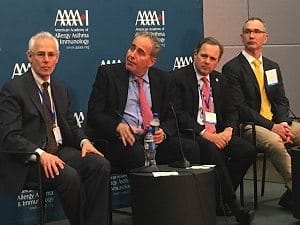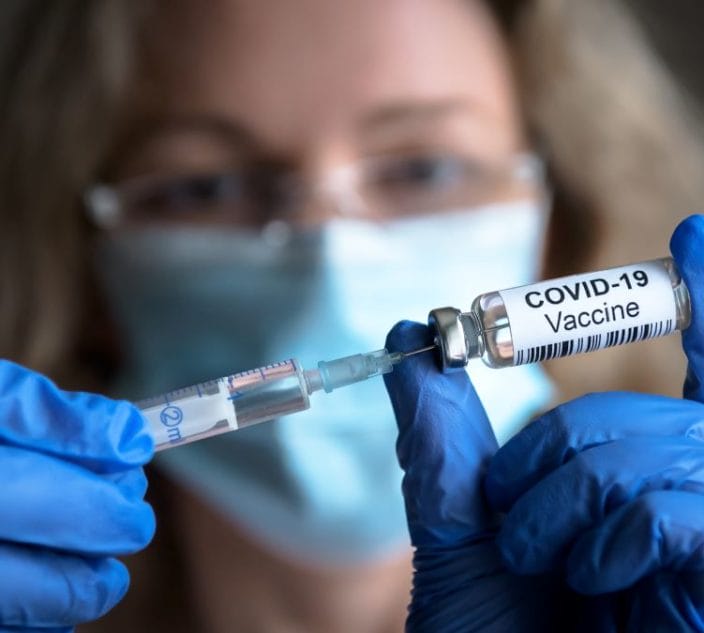 NIAID’s Dr. Daniel Rotrosen, LEAP studies author Dr. Gideon Lack, Dr. James Baker of FARE, and LEAP studies co-author Dr. George Du Toit. Photo: Allergic Living
NIAID’s Dr. Daniel Rotrosen, LEAP studies author Dr. Gideon Lack, Dr. James Baker of FARE, and LEAP studies co-author Dr. George Du Toit. Photo: Allergic Living There’s no denying that the results of 2015’s LEAP and the newer LEAP-On are quite phenomenal – a 74 to 80 percent reduction in peanut allergy among children at high risk for allergy who began consuming the much-maligned legume in infancy. “I think there’s no doubt that we have prevented allergy in these children, at least so far,” said LEAP-On co-author Dr. Gideon Lack, speaking of the cohort of kids who are now 6 years old.
That’s right, prevented.
So why aren’t the champagne corks flying as we contemplate a next generation of kids who may get to avoid the scourge of peanut allergy? There are a couple of reasons. First, introducing such an allergenic food to an at-risk baby of only 4 to 6 months is intimidating to contemplate. In fact, it’s the polar opposite of the avoidance messages that were etched into our brains. And second, the whole “when to introduce foods question” has now, officially, been turned on its head. That’s a huge culture change for the allergy community. Let’s face it, it’s a lot to absorb.
It seems only yesterday that every doctor recommended the old guidelines: don’t feed your baby at-risk of food allergy dairy products until after the age of 1, eggs until after age 2, and do avoid giving the child tree nuts, peanuts or fish until the age of 3. That questionable advice was officially tossed out by the American Academy of Pediatrics (AAP) in 2008. Two years before that, at Allergic Living, we had a head’s up that change was in the wind.
The first clue was when we asked the late, great Canadian allergist Dr. Milton Gold what he thought of the curiously age-specific guidance. “It’s more than mumbo-jumbo, it’s a mess that has to change. It has no basis in science,” he said with clear frustration.
Allergy Prevention Skepticism
In 2008, the AAP issued guidelines that reflected the lack of science. They were honest, if un-illuminating. On the question of when to introduce solids, they essentially said there was no evidence to support avoidance of any solid foods beyond the exclusive breastfeeding-only window of up to 4 to 6 months. The message to expecting or new parents seemed to be: Avoidance isn’t working but we really don’t know what to say about solids introduction. So thanks, and see you at the next checkup!
With the arrival of 2015’s groundbreaking LEAP study, the advice to parents changed dramatically, and it is finally based on real and persuasive evidence. Now, in keeping with the results of both LEAP studies, the U.S. National Institute of Allergy and Infectious Diseases (NIAID), has unveiled its draft guidelines for early introduction for the prevention of peanut allergy. You can read the specifics here [update: the guidelines are now published and official.]
They recommend that – for babies of 4 to 6 months who have severe eczema or egg allergy – doctors consider testing for peanut sensitivity. If there is no clear allergy but some suspicion, a doctor may additionally suggest an oral food challenge. If all is well, then let the peanut introduction begin.
But this won’t be an easy sell to a public that’s been perplexed by the epidemic-like rise of food allergies since the early 2000s – and the experts know this.
Culture Change to Prevent Allergy
Lack and Dr. James Baker of FARE raised what they see as the need for a “change in culture” as they spoke to journalists at the LEAP-On press conference at the AAAAI annual meeting in March 2016.
“I think [the new approach] needs education, support, a change in culture, not just among patients, but physicians,” said Lack. He spoke of the widespread acceptance of delayed allergen introduction and how countless parenting books promote it. “This instills a culture of fear in the parents and the families, and I think we need a lot more research and good advice on feeding policies in infants. So that we can go to parents and say: ‘This is what we recommend, this is how to do it,’” said Lack.
Baker picked up on the culture change theme. “I think for a long time we vilified these [allergenic] foods, and there’s nothing inherently wrong with intake.”
In the related EAT study, parents tried to introduce up to six potentially allergenic foods with mixed success, but no serious reactions. Baker says, “The EAT study reinforces how complex and difficult it is to be a parent, and to try to feed your child and do the right thing. When you get these negative perceptions of foods, it puts a lot of stress on families.”
“The good news about this information is that there’s no reason not to do this, there’s no harm that has come from early introduction,” he said.
In science, food introduction is clearly winning out over avoidance as the right approach. However, with vulnerable babies, there remains such emotion for the parent, such a visceral need to protect. Avoidance not only hasn’t worked, but appears to have promoted allergies. Yet it was so easy to buy into.
There were no intimidating baby spoonfuls; baby just didn’t eat that. But if we take heart in the good safety profile of the LEAP and EAT studies, perhaps as a community we can change our culture, moving away from our comfortable attachment to avoidance.
Communications Challenge
I’ve been a journalist for a long while, and I recognize a communications challenge when I see one. Getting across the news of the proposed guidelines will require considerable effort, and both parents and doctors will have many questions, including the “how-to” ones that Lack raises.
NIAID assures me that the organization will will issue supporting materials for doctors and the public, and encourage their dissemination.
For starters, parents and doctors will need to be educated on the strength of the LEAP studies’ evidence. Lack’s co-author, Dr. George Du Toit, says he uses that to help parents at his London clinic to make an informed decision. When considering a young infant at high risk for allergy, he will tell them that avoidance carries a potential 18 percent risk of peanut allergy.
“Maybe you’ll be lucky and fall into those whose child doesn’t get the allergy, but an 18 percent rate of a troubling illness is quite high,” he says. With early introduction intervention in high-risk children, the peanut allergy odds plummet to 3 percent.
So take faith in this: we finally have a start on food allergy prevention, and it begins with peanut allergy. Science-based guidelines are replacing the “mumbo-jumbo” ways of old. Moving forward, the heavy-lifting involves how to bring this new evidence home to our physicians, our food allergy families and their babies.
For years, we had no proof of whether introduction of a food like peanut helped or harmed. Now we do. This is progress, but progress that will only take hold alongside a significant culture change.
****
The NIAID guidelines on peanut introduction were introduced in January, 2017. Read about them here. If you have a question for our experts about early introduction of allergenic foods, send it to [email protected] and write “Ask the Allergist” in the subject line. All questions are considered, though not every one can be answered.
Related Reading:
Guidelines on Introducing Peanut to Babies
Parents Struggle to Adapt to New Infant Guidelines





